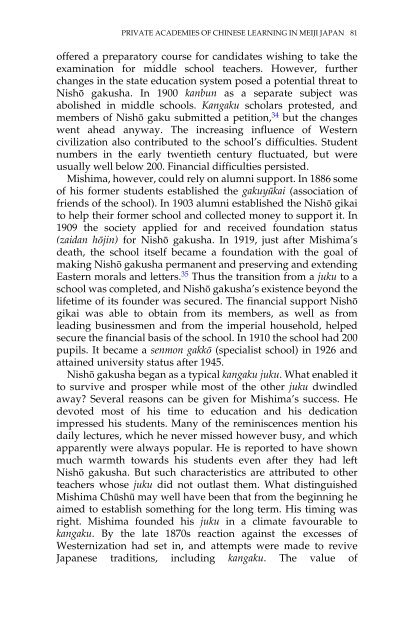Private Academies of Chinese Learning in Meiji Japan: The Decline ...
Private Academies of Chinese Learning in Meiji Japan: The Decline ...
Private Academies of Chinese Learning in Meiji Japan: The Decline ...
You also want an ePaper? Increase the reach of your titles
YUMPU automatically turns print PDFs into web optimized ePapers that Google loves.
PRIVATE ACADEMIES OF CHINESE LEARNING IN MEIJI JAPAN 81<strong>of</strong>fered a preparatory course for candidates wish<strong>in</strong>g to take theexam<strong>in</strong>ation for middle school teachers. However, furtherchanges <strong>in</strong> the state education system posed a potential threat toNishō gakusha. In 1900 kanbun as a separate subject wasabolished <strong>in</strong> middle schools. Kangaku scholars protested, andmembers <strong>of</strong> Nishō gaku submitted a petition, 34 but the changeswent ahead anyway. <strong>The</strong> <strong>in</strong>creas<strong>in</strong>g <strong>in</strong>fluence <strong>of</strong> Westerncivilization also contributed to the school’s difficulties. Studentnumbers <strong>in</strong> the early twentieth century fluctuated, but wereusually well below 200. F<strong>in</strong>ancial difficulties persisted.Mishima, however, could rely on alumni support. In 1886 some<strong>of</strong> his former students established the gakuyūkai (association <strong>of</strong>friends <strong>of</strong> the school). In 1903 alumni established the Nishō gikaito help their former school and collected money to support it. In1909 the society applied for and received foundation status(zaidan hōj<strong>in</strong>) for Nishō gakusha. In 1919, just after Mishima’sdeath, the school itself became a foundation with the goal <strong>of</strong>mak<strong>in</strong>g Nishō gakusha permanent and preserv<strong>in</strong>g and extend<strong>in</strong>gEastern morals and letters. 35 Thus the transition from a juku to aschool was completed, and Nishō gakusha’s existence beyond thelifetime <strong>of</strong> its founder was secured. <strong>The</strong> f<strong>in</strong>ancial support Nishōgikai was able to obta<strong>in</strong> from its members, as well as fromlead<strong>in</strong>g bus<strong>in</strong>essmen and from the imperial household, helpedsecure the f<strong>in</strong>ancial basis <strong>of</strong> the school. In 1910 the school had 200pupils. It became a senmon gakkō (specialist school) <strong>in</strong> 1926 andatta<strong>in</strong>ed university status after 1945.Nishō gakusha began as a typical kangaku juku. What enabled itto survive and prosper while most <strong>of</strong> the other juku dw<strong>in</strong>dledaway? Several reasons can be given for Mishima’s success. Hedevoted most <strong>of</strong> his time to education and his dedicationimpressed his students. Many <strong>of</strong> the rem<strong>in</strong>iscences mention hisdaily lectures, which he never missed however busy, and whichapparently were always popular. He is reported to have shownmuch warmth towards his students even after they had leftNishō gakusha. But such characteristics are attributed to otherteachers whose juku did not outlast them. What dist<strong>in</strong>guishedMishima Chūshū may well have been that from the beg<strong>in</strong>n<strong>in</strong>g heaimed to establish someth<strong>in</strong>g for the long term. His tim<strong>in</strong>g wasright. Mishima founded his juku <strong>in</strong> a climate favourable tokangaku. By the late 1870s reaction aga<strong>in</strong>st the excesses <strong>of</strong>Westernization had set <strong>in</strong>, and attempts were made to revive<strong>Japan</strong>ese traditions, <strong>in</strong>clud<strong>in</strong>g kangaku. <strong>The</strong> value <strong>of</strong>













